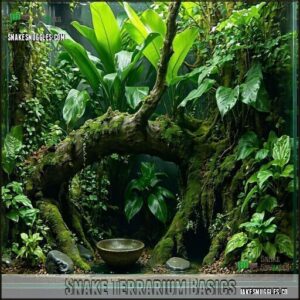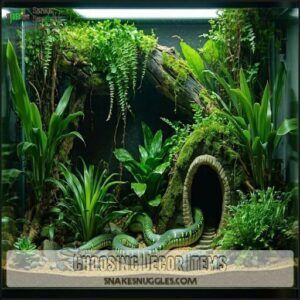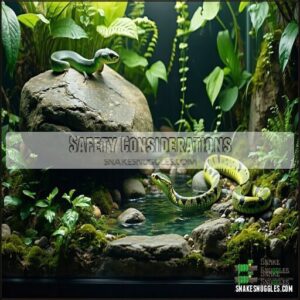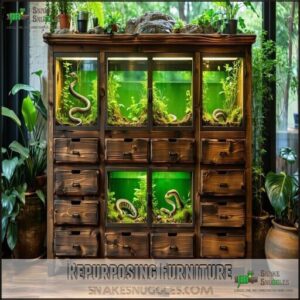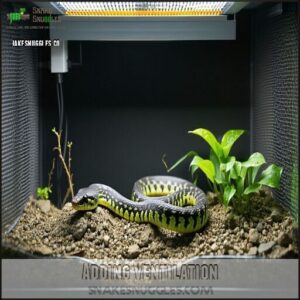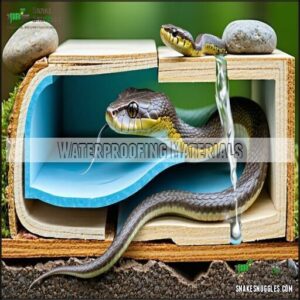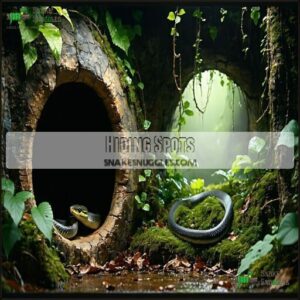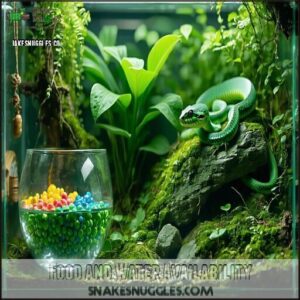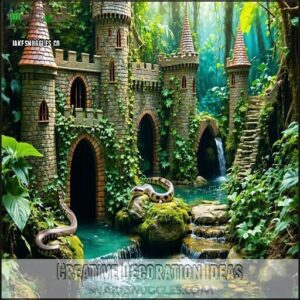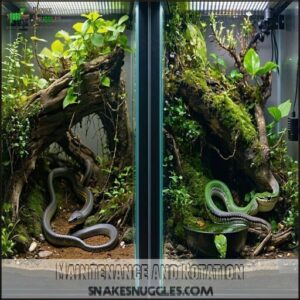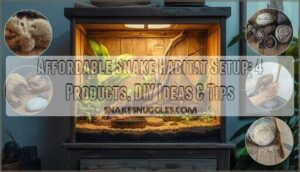This site is supported by our readers. We may earn a commission, at no cost to you, if you purchase through links.
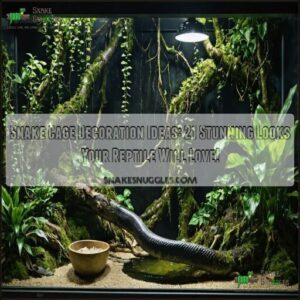
Include climbing branches, hiding spots (like hollow logs or rock caves), and substrate that matches your snake’s species needs.
Artificial plants work great if you’re not blessed with a green thumb! Position a sturdy water dish where it won’t tip over—snakes appreciate a good soak just like we enjoy a relaxing bath.
Remember that less is more; your snake needs room to stretch out and explore.
The perfect enclosure balances aesthetics with functionality, turning an ordinary tank into a slice of reptilian paradise.
Table Of Contents
- Key Takeaways
- Snake Terrarium Basics
- Choosing Decor Items
- Safety Considerations
- DIY Snake Enclosures
- Snake Cage Requirements
- Creative Decoration Ideas
- Maintenance and Rotation
- Frequently Asked Questions (FAQs)
- What is a DIY snake cage enclosure?
- How to make a snake cage?
- What is a snake cage made out of?
- What materials do you need for a snake cage?
- How do you decorate a snake terrarium?
- How to make a snake hide?
- Where Can I Purchase the Recommended Snake Terrarium Decorations?
- What is the Recommended Size for a Snake Terrarium?
- How Often Should I Rotate the Decorations in My Snake’s Terrarium?
- Can I Use Real Plants in My Snake’s Terrarium?
- Conclusion
Key Takeaways
- You’ll create a healthier environment for your snake by mimicking its natural habitat with appropriate substrate, climbing branches, and hiding spots that encourage natural behaviors.
- You should balance aesthetics with functionality in your snake’s enclosure, ensuring there’s enough space for movement while including essential elements like secure water dishes and proper heat sources.
- You’ll need to use only non-toxic materials in your terrarium decorations, avoiding sharp edges and ensuring all items are properly secured to prevent injuries to your scaly friend.
- You can rotate decorations every 4-6 weeks to provide enrichment and prevent boredom, while maintaining a regular cleaning schedule to prevent bacterial growth and keep your snake healthy.
Snake Terrarium Basics
You’ll need to create a comfy home that keeps your snake healthy and happy before adding all those cool decorations.
Your scaly friend doesn’t care about Instagram likes, but they do need the right temperature, hiding spots, and non-toxic materials that mimic their natural habitat, including the need for hiding spots.
Essential Decor Functions
Snake cage decorations are more than just eye candy – they’re essential for your reptile’s wellbeing.
When setting up your terrarium, remember that good decor serves three essential functions:
- Enrichment provision through climbing structures and exploration opportunities
- Temperature regulation with basking spots and cool retreats
- Stress reduction by offering hiding spots that make your snake feel secure
Think of decorations as your snake’s furniture, playground, and security system all rolled into one!
Natural Habitat Inspiration
Looking to your snake’s wild origins isn’t just about pretty decorations – it’s about creating a slice of their natural world right in your living room.
| Habitat Type | Key Elements | Species Match |
|---|---|---|
| Desert terrariums | Rocky outcrops, minimal plants | Sand boas, Hognose snakes |
| Forest floors | Leaf litter, logs, moss | Ball pythons, Milk snakes |
| Jungle themes | Dense plants, climbing branches | Tree pythons, Vine snakes |
Mimicking these natural habitats helps your slithery friend feel secure and encourages natural behaviors.
Non-Toxic Materials
Choosing non-toxic materials for your snake terrarium isn’t just smart—it’s essential for your reptile’s wellbeing.
Not all decorations are created equal in terms of safety.
Here are five snake-safe materials that won’t harm your scaly friend:
- Natural cork bark (perfect for climbing and hiding)
- Untreated wood branches (avoid pine and cedar)
- Ceramic hides (easy to clean and durable)
- Safe substrates like coconut fiber
- Plastic plant alternatives (when live plants aren’t practical)
These materials are essential for creating a safe environment, and using them can help ensure your snake’s health.
Choosing Decor Items
You’ll want to pick decor items that both look great and serve your snake’s natural needs, like places to hide, climb, and explore.
From realistic-looking artificial plants to natural cork bark that doubles as a cozy hideout, the right decorations can transform your snake’s cage from a basic box into a reptile paradise where your scaly friend can thrive.
Live Plants Benefits
Live plants can spruce up your snake cage decor while providing natural benefits your reptile will appreciate.
Live plants transform your snake’s enclosure from a mere cage into a thriving sanctuary that supports natural behaviors.
These terrarium decorations assist with shedding, offer extra hiding places, and contribute to natural humidity levels.
Your snake will feel more at home surrounded by oxygen-producing greenery like Pothos or Syngonium.
For a complete ecosystem simulation, combine snake plant decor with bioactive elements like springtails and isopods.
Just make sure all reptile safe plants are properly researched before adding them!
Artificial Decor Options
When the appeal of artificial decor enters your snake’s world, you’ll find countless options that combine style with practicality.
Artificial snake plants offer worry-free maintenance and lasting beauty.
Here are five artificial decor advantages:
- Maintenance ease – simply wipe clean with mild soap
- Cost effectiveness over time (no replacements needed)
- Durability factors that withstand humidity
- Aesthetic variety with silicone-based artificial plants
- Safety concerns addressed with non-toxic materials
These plants are easy to find if you shop artificial varieties.
Your terrarium decorations can be both beautiful and functional!
Bioactive Elements
Three key bioactive elements transform your snake’s enclosure into a mini-ecosystem that practically maintains itself.
Cleanup crews like springtails and isopods break down waste, while the right soil composition and plant selection create a natural habitat that’s both beautiful and functional.
| Bioactive Element | Benefits | Examples | Maintenance | Best For |
|---|---|---|---|---|
| Cleanup Crews | Waste breakdown, pest control | Springtails, isopods | Self-sustaining | All snake species |
| Soil Composition | Moisture retention, plant growth | ABG mix, bioactive substrate | Yearly replacement | Humidity-loving snakes |
| Plant Selection | Oxygen, humidity, enrichment | Pothos, snake plant | Occasional pruning | Arboreal species |
| Leaf Litter | Microhabitats, humidity | Oak leaves, magnolia | Add fresh batches | Forest dwellers |
| Bioactive Drainage | Prevents mold, root rot | LECA, gravel | Clean yearly | Tropical setups |
The bioactive approach includes elements like leaf litter and bioactive drainage to create a thriving environment for your snake, with benefits such as moisture retention and oxygen production.
This setup is ideal for various snake species, including arboreal species and humidity-loving snakes, providing them with a natural and self-sustaining habitat.
Safety Considerations
You’ll need to make sure your snake’s decorations won’t topple over or hurt them, just like you wouldn’t want furniture falling on your toes.
Always check for sharp edges and secure heavy items properly so your scaly friend can safely explore their stylish new home.
Secure Placement
In terms of snake terrarium decor, nailing down secure placement is a must for your slithery friend’s safety.
Confirm all decorations have proper anchor points that won’t budge as your snake explores.
Match items to your terrarium size and consider your snake’s habits—climbers need extra-secure branches while burrowers need safely arranged hides.
Remember, a toppling rock or branch isn’t just messy—it could harm your scaly companion.
A vital element involves understanding proper ventilation systems to maintain a healthy environment.
Weight Limits
Now that you have your decorations securely anchored, let’s talk about how much weight your terrarium can actually handle. Your snake cage decoration ideas need to account for the physical limits of your enclosure—especially the terrarium base and glass thickness.
- Always check manufacturer guidelines for maximum decor density
- Distribute heavy terrarium decor items across the bottom rather than stacking them
- Consider rock stability when using natural stones (they’re heavier than they look!)
- Install proper support structures for branches that your snake will climb on
Remember, that cute corn snake might grow into a hefty python someday. Planning your cage decoration with future growth in mind saves you from a surprise crack in your enclosure later, which could be due to improper support or excessive weight. This consideration is crucial for the long-term safety of your pet.
Avoiding Sharp Edges
While balancing weight distribution keeps your snake secure, don’t overlook those sneaky sharp edges lurking on cage decorations.
Always inspect your decor items before installation. Run your fingers along all surfaces—if it feels uncomfortable to your touch, imagine how it might affect your scaly friend.
Sand down rough surfaces on wood pieces and file away any pointed corners on rocks. Nontoxic materials with smooth edges are your best bet for injury prevention.
DIY Snake Enclosures
You’ll save big bucks and create the perfect home for your scaly friend when you build your own snake enclosure from repurposed furniture or basic materials.
With just some simple tools and waterproofing know-how, you can craft a custom reptile palace that’s exactly the right size and style for your particular snake’s needs.
Repurposing Furniture
Transform old furniture into amazing snake homes! Repurposing dressers, bookcases, or cabinets saves money while creating unique enclosures that fit your space perfectly.
- Old wooden dressers offer multiple compartments for different species or temperature zones
- Entertainment centers provide excellent width for larger snakes to stretch out comfortably
- Nightstands work wonderfully for smaller species while maintaining your room’s decor style
Just remember to check furniture safety and material choices before starting your DIY project!
Adding Ventilation
When designing your DIY snake enclosure, proper ventilation becomes the breath of life for your scaly friend.
You’ll need strategic airflow to maintain ideal temperature and humidity levels. Insufficient airflow can lead to respiratory health risks for your snake.
| Ventilation Type | Placement Areas | Benefits |
|---|---|---|
| Mesh Screens | Top/sides | Excellent airflow, prevents escapees |
| Drilled Holes | Upper walls | Easy DIY option, customizable |
| Vented Panels | Front/back | Professional look, controlled airflow |
| PVC Vents | Bottom areas | Helps with humidity control, durable |
The table above outlines different ventilation options, each with its unique benefits, such as excellent airflow and humidity control.
Waterproofing Materials
Moisture protection is essential for your DIY snake enclosure’s longevity.
Melamine needs minimal waterproofing—just silicone the interior edges. For plywood or PVC, pond shield sealant works wonders.
You can find various sealant products online.
Need extra durability? Reinforce edges with fiberglass sheets.
Silicone sealants and gorilla glue create waterproof bonds in your snake habitat. For ultimate protection, try marine-grade boat paints on your tank construction.
Your slithery friend will thank you!
Snake Cage Requirements
Before you start adding all those cool decorations to your snake’s home, you’ll need to make sure you’ve got the basics covered like heat sources, hiding spots, and proper food and water areas.
Your scaly friend doesn’t ask for much, but meeting these fundamental requirements will keep them healthy and happy while those fancy decorations keep them entertained.
Heat Sources
Every snake needs a toasty spot to call home.
You’ll want to create a temperature gradient in your snake’s enclosure using heat mats or heating pads for belly heat, basking bulbs for overhead warmth, or ceramic heaters for nighttime heat.
Always connect these to a thermostat control to prevent overheating. Many owners purchase reptile heat mats for their enclosures.
Your scaly friend relies on external heat sources for digestion and activity – proper thermal regulation is non-negotiable, and it’s crucial for their well-being to have a temperature gradient.
Hiding Spots
Snakes absolutely need secure hiding spots in their cages to feel safe and reduce stress.
You’ll want at least two hides—one on the warm side and another on the cool side. Enclosed caves, flowerpot hides, and cork bark create perfect snake hides that double as decorative elements.
Branch cover with artificial plants offers additional security. For shedding time, create humid microclimates inside one hide using slightly damp sphagnum moss—your slithery friend will thank you for the perfect snake hides.
Food and Water Availability
Beyond just a cozy hiding place, your snake needs regular access to fresh water and food.
Pick a water dish size that’s big enough for soaking but won’t tip over. Keep it clean – snakes aren’t picky about water source hygiene!
Position food and water dishes away from heating elements, and consider decorative options that blend with your theme.
Some owners use automatic feeders for feeding schedule consistency. Remember: stylish doesn’t have to sacrifice function!
Creative Decoration Ideas
You’ll transform your snake’s home into a reptile paradise with these creative decoration themes that stimulate natural behaviors and reduce stress.
Whether you choose a lush tropical rainforest, a warm desert oasis, or a whimsical fantasy castle, your scaly friend will thank you with more active exploration and healthier shedding cycles, experiencing a significant improvement in their overall well-being due to natural behaviors.
Tropical Rainforest Theme
Transform your snake’s home into a lush paradise with a tropical rainforest theme! Your scaly friend will feel right at home surrounded by dense vegetation and natural elements that mimic their wild habitat.
- Layer faux plants for realistic canopy coverage without maintenance hassles
- Install climbing vines for natural exploration opportunities
- Add a misting system for perfect humidity control
- Incorporate cork bark hideaways among the greenery
- Use artificial plants with varied leaf sizes for depth and dimension to create a natural habitat with perfect humidity
Desert Oasis Theme
While rainforests offer lush environments, a desert oasis theme creates the perfect habitat for arid-dwelling snake species.
You’ll need warm hues, strategically placed rocks, and minimal vegetation to mimic natural desert conditions.
| Desert Element | Benefits for Snakes | Best Options | Maintenance | Cost Range |
|---|---|---|---|---|
| Sand Substrates | Promotes burrowing | Reptile sand | Replace monthly | $10-20 |
| Rock Selection | Creates hiding spots | Slate, sandstone | Wash occasionally | $5-15 |
| Succulent Types | Low moisture needs | Fake varieties | Dust monthly | $8-25 |
| Arid Plants | Natural aesthetics | Artificial yucca | Minimal cleaning | $12-30 |
| Background Décor | Completes the look | Cork tiles | Wipe when needed | $15-40 |
The table outlines the essential desert elements for creating an ideal environment, including sand substrates, rock selection, and succulent types, each with its benefits, best options, maintenance requirements, and cost range.
Fantasy Castle Theme
Turn your snake cage into a magical kingdom with a fantasy castle theme.
Set up miniature castle structures as hiding spots, then add fairy lights for a mystical glow.
Dragon decor pieces work great as basking spots, while themed backgrounds create depth.
You can even include small mythical creatures as decoration elements.
Proper enclosure size is essential for reducing stress.
Your snake will love exploring this enchanted playground while you enjoy the whimsical decor and understand the importance of a proper enclosure.
Maintenance and Rotation
You’ll need to clean your snake’s decorations regularly and switch them around sometimes to keep your slithery friend healthy and interested in its surroundings.
Just like how you’d get bored looking at the same picture on your wall for years, your snake enjoys a change of scenery that stimulates natural behaviors while preventing bacteria buildup that could make it sick, which is essential for maintaining its health and preventing it from getting sick.
Regular Cleaning
Regular cleaning routines are the backbone of healthy snake enclosures.
Your snake cage cleaning schedule should include daily spot checks, weekly substrate replacement, and monthly disinfection of all decor items.
Use mild soap and water for decor disinfection, avoiding harsh chemicals that could harm your reptile.
Always make certain of safe rinsing and complete drying before returning items to the enclosure.
Proper snake enclosure maintenance prevents bacterial growth and keeps your slithery friend happy.
Rotating Decorations
Now that you’ve mastered the cleaning routine, let’s keep your snake engaged.
Swap out decor items every 4-6 weeks to prevent boredom. Your scaly friend will appreciate the behavioral enrichment and fresh perspective.
Moving branches, caves, or artificial plants stimulates exploration and provides habitat variety.
Remember that lush foliage creates stealth opportunities for your snake.
Think of it as redecorating your snake’s apartment – they’ll investigate every new nook with renewed curiosity. Simple snake cage decoration changes can spark days of enrichment activities and provide a new fresh perspective for your snake, enhancing their overall experience with stealth opportunities.
Monitoring Snake Behavior
Your snake’s behavior speaks volumes about their enclosure’s success.
Watch for healthy eating habits, smooth shedding patterns, and consistent activity levels. If they’re avoiding certain snake cage decoration elements or showing stress signs like hiding excessively, it’s time to adjust.
Behavioral enrichment isn’t just pretty—it’s functional! Notice how they interact with different enrichment features.
A happy snake actively explores, basks comfortably, and shows curiosity without stress signals, indicating a successful and functional environment.
Frequently Asked Questions (FAQs)
What is a DIY snake cage enclosure?
Ever dreamed of a custom reptile home?
You can create your own snake enclosure by repurposing furniture like cabinets or building from scratch with plywood, saving money while designing the perfect habitat for your pet.
How to make a snake cage?
You’ll need to gather plywood, a saw, and ventilation materials.
Cut the wood to size, create a door, add ventilation holes, and secure everything with silicone sealant.
Don’t forget heating elements!
What is a snake cage made out of?
You’ll typically build your snake enclosure from glass terrariums, plastic tubs, PVC cages, wooden vivariums, or repurposed furniture. Each material offers different benefits for humidity control, visibility, insulation, and cost-effectiveness.
What materials do you need for a snake cage?
As solid as a rock, you’ll need secure enclosure materials like glass or plastic, appropriate substrate, heating elements, hiding spots, water dish, thermometer, and humidity gauge for your snake’s home.
How do you decorate a snake terrarium?
Add hiding spots like cork bark or flowerpots, incorporate climbing branches, use safe plants (real or artificial), and create zones for basking and cooling.
Don’t overcrowd—your snake needs room to explore its mini-jungle!
How to make a snake hide?
You can create a snake hide using an inverted flowerpot with a doorway cutout, a cardboard box with holes, or cork bark tubes.
These provide safe, cozy retreats where your slithery friend can relax.
Where Can I Purchase the Recommended Snake Terrarium Decorations?
You’ll find snake decor at PetSmart, Petco, and Chewy for mainstream options.
Don’t forget specialty retailers like ReptileSupply.com and The Bio Dude.
Craft stores offer cheaper fake plants, while Etsy has unique pieces.
What is the Recommended Size for a Snake Terrarium?
Your snake’s home should be at least 5 times their adult length in size.
You’ll want enough width for them to coil comfortably plus room for hideaways, water dishes, and climbing branches.
How Often Should I Rotate the Decorations in My Snake’s Terrarium?
You’ll want to refresh your snake’s environment every 4-6 weeks.
This mimics natural habitat changes, prevents boredom, and stimulates exploration.
Too frequent changes might stress them, while too few can lead to understimulation.
Can I Use Real Plants in My Snake’s Terrarium?
Yes, you can use real plants in your snake’s terrarium.
They’ll provide natural humidity and visual interest, but make certain they’re non-toxic and properly secured.
You’ll need to maintain them regularly for your snake’s safety.
Conclusion
Surprisingly, the best snake cage decoration ideas aren’t complicated or expensive.
You’ll find that thoughtful habitat design substantially improves your reptile’s health and behavior.
By incorporating elements that mimic their natural environment, you’re creating more than just a pretty display—you’re building a functional home.
Whether you prefer desert landscapes or lush jungles, remember that your snake’s needs come first.
With these decoration tips, you’ll transform an ordinary enclosure into a thriving sanctuary your scaly friend will actually enjoy, creating a space that is both aesthetically pleasing and improves your reptile’s health.
- https://animals.mom.com/homemade-decorations-snake-cage-6815.html
- https://www.reptilecentre.com/blogs/reptile-blog/5-awesome-decorations-for-a-corn-snake
- https://www.jabberwockreptiles.com/news/buy-decorations-for-your-reptile-cage/
- https://www.thebiodude.com/collections/bioactive-snake-terrarium-kits
- https://reptilesupply.com/collections/reptile-decor

